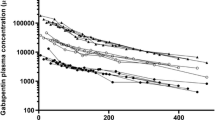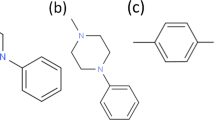Abstract
Purpose. This study on the intestinal transport of β-lactam antibiotics was undertaken to investigate the correlation between cellular transport parameters and the bioavailability.
Methods. Transport of 23 β-lactam antibiotics was characterized by measuring their ability to inhibit the uptake of glycylsarcosine into Caco-2 cells, their uptake into the cells and their total flux across the cell monolayers.
Results. Ceftibuten and cyclacillin were recognized by PEPT1 with affinity constants comparable to those of natural dipeptides (Ki = 0.3 and 0.5 mM, respectively). Cefadroxil, cefamandole, cephradine, cefaclor, cefuroxime-axetil, cefixime, cephalotin, cephalexin and ampicillin also interacted with PEPT1 (Ki = 7-14 mM). In contrast, cefapirin, cefodizime, cefuroxime, cefmetazole, ceftazidime, benzyl-penicillin, ceftriaxone, cefpirome, cefotaxime, cefepime, cephaloridine and cefsulodin displayed no affinity to the transport system (Ki > 20 mM). The uptake into the cells and the transepithelial flux was highest for those β-lactam antibiotics, which showed the strongest inhibition of [14C]Gly-Sar transport (p < 0.0001). Exceptions were cefuroxim-axetil and cephalotin.
Conclusions. The probability of oral bioavailability for β-lactam antibiotics is mainly determined by their affinity to PEPT1. A threshold Ki value of 14 mM with respect to Gly-Sar uptake is required.
Similar content being viewed by others
REFERENCES
A. Tsuji. Intestinal absorption of β-lactam antibiotics. In M. D. Taylor and G. L. Amidon (eds.) Peptide-based drug design. American Chemical Society, Washington, DC., 1995, pp. 101–134.
E. Walter, T. Kissel, and G. L. Amidon. The intestinal peptide carrier: A potential transport system for small peptide derived drugs. Adv. Drug Del. Rev. 20:33–58 (1996).
K.-I. Inui, T. Okano, H. Maegawa, M. Kato, M. Takano, and R. Hori. H+ coupled transport of p.o. cephalosporins via dipeptide carriers in rabbit intestinal brush-border membranes: difference of transport characteristics between cefixime and cephradine. J. Pharm. Exp. Ther. 247:235–241 (1988).
N. Muranushi, T. Yoshikawa, M. Yoshida, T. Oguma, K. Hirano, and H. Yamada. Transport characteristics of ceftibuten, a new oral cephem, in rat intestinal brush-border membrane vesicles: relationship to oligopeptide and amino β-lactam transport. Pharm. Res. 6:308–312 (1989).
A. H. Dantzig, D. C. Duckworth, and L. B. Tabas. Transport mechanisms responsible for the absorption of loracarbef, cefixime, and cefuroxime axetil into human intestinal Caco-2 cells. Biochim. Biophys. Acta 1191:7–13 (1994).
S.-I. Matsumoto, H. Saito, and K.-I. Inui. Transcellular transport of oral cephalosporins in human intestinal epithelial cells, Caco-2: interaction with dipeptide transport systems in apical and basolateral membranes. J. Pharm. Exp. Ther. 270:498–504 (1994).
C. H. Gochoco, F. M. Ryan, J. Miller, P. L. Smith, and I. J. Hidalgo. Uptake and transepithelial transport of the orally absorbed cephalosporin cephalexin, in the human intestinal cell line, Caco-2. Int. J. Pharm. 104:187–202 (1994).
M. E. Ganapathy, M. Brandsch, P. D. Prasad, V. Ganapathy, and F. H. Leibach. Differential recognition of β-lactam antibiotics by intestinal and renal peptide transporters, PEPT 1 and PEPT 2. J. Biol. Chem. 270:25672–25677 (1995).
U. Wenzel, I. Gebert, H. Weintraut, W.-M. Weber, W. Clauß, and H. Daniel. Transport characteristics of differently charged cephalosporin antibiotics in oocytes expressing the cloned intestinal peptide transporter PepT1 and in human intestinal Caco-2 cells. J. Pharm. Exp. Ther. 277:831–839 (1996).
T. Terada, H. Saito, M. Mukai, and K.-I. Inui. Recognition of β-lactam antibiotics by rat peptide transporters, PEPT1 and PEPT2, in LLC-PK1 cells. Am. J. Physiol. 273:F706–F711 (1997).
N. J. Snyder, L. B. Tabas, D. M. Berry, D. C. Duckworth, D. O. Spry, and A. H. Dantzig. Structure-activity relationship of carbacephalosporins and cephalosporins: antibacterial activity and interaction with the intestinal proton-dependent dipeptide transport carrier of Caco-2 cells. Antimicrob. Agents Chemother. 41:1649–1657 (1997).
F. H. Leibach and V. Ganapathy. Peptide transporters in the intestine and the kidney. Annu. Rev. Nutr. 16:99–119 (1996).
S. A. Adibi. The oligopeptide transporter (Pept-1) in human intestine: biology and function, Gastroenterology 113:332–340 (1997).
S. Nussberger, A. Steel, and M. A. Hediger. Structure and pharmacology of proton-linked peptide transporters. J. Contr. Rel. 46:31–38 (1997).
H. Daniel. Function and molecular structure of brush border membrane peptide/H+ symporters. J. Membr. Biol. 154:197–203 (1996).
H. Daniel and S. A. Adibi. Transport of β-lactam antibiotics in kidney brush border membrane. Determinants of their affinity for the oligopeptide/H+ symporter. J. Clin. Invest. 92:2215–2223 (1993).
M. Brandsch, Y. Miyamoto, V. Ganapathy, and F. H. Leibach. Expression and protein kinase C-dependent regulation of peptide/H+ co-transport system in the Caco-2 human colon carcinoma cell line. Biochem. J. 299:253–260 (1994).
M. Brandsch, S. Ramamoorthy, N. Marczin, J. D. Catravas, J. W. Leibach, V. Ganapathy, and F. H. Leibach. Regulation of taurine transport by Escherichia coli heat-stable enterotoxin and guanylin in human intestinal cell lines. J. Clin. Invest. 96:361–369 (1995).
F. Delie and W. Rubas. A human colonic cell line sharing similarities with enterocytes as a model to examine oral absorption: Advantages and limitations of the Caco-2 model. Crit. Rev. Ther. Drug Carrier Syst. 14:221–286 (1997).
J. Li and I. J. Hidalgo. Molecular modeling study of structural requirements for the oligopeptide transporter. J. Drug Target 4:9–17 (1996).
P. W. Swaan and J. J. Tukker. Molecular determinants of recognition for the intestinal peptide carrier. J. Pharm. Sci. 86:596–602 (1997).
C. Simon and W. Stille. Antibiotika—Therapie in Klinik und Praxis. 7th edition, 1989, Schattauer, Stuttgart-New York.
P. L. Smith, D. A. Wall, C. H. Gochoco, and G. Wilson. Routes of delivery: Case studies. Oral absorption of peptides and proteins. Adv. Drug. Del. Rev. 8:253–290 (1992).
M. E. Ganapathy, P. D. Prasad, B. Mackenzie, V. Ganapathy, and F. H. Leibach. Interaction of anionic cephalosporins with the intestinal and renal peptide transporters PEPT 1 and PEPT 2. Biochim. Biophys. Acta 1324:296–308 (1997).
A. Blais, P. Bissonnette, and A. Berteloot. Common characteristics for Na+-dependent sugar transport in Caco-2 cells and human fetal colon. J. Membr. Biol. 99:113–125 (1987).
A. Tsuji, I. Tamai, M. Nakanishi, T. Terasaki, and S. Hamano. Intestinal brush-border transport of the oral cephalosporin antibiotic, cefdinir, mediated by dipeptide and monocarboxylic acid transport systems in rabbits. J. Pharm. Pharmacol. 45:996–998 (1993).
H. Saitoh, C. Gerard, and B. J. Aungst. The secretory intestinal transport of some β-lactam antibiotics and anionic compounds: a mechanism contributing to poor oral absorption. J. Pharmacol. Exp. Ther. 278:205–211 (1996).
I. Tamai, T. Nakanishi, K. Hayashi, T. Terao, Y. Sai, T. Shiraga, K. I. Miyamoto, E. Takeda, H. Higashida, and A. Tsuji. The predominant contribution of oligopeptide transporter PepT1 to intestinal absorption of β-lactam antibiotics in rat small intestine. J. Pharm. Pharmacol. 49:796–801 (1997).
Author information
Authors and Affiliations
Corresponding author
Rights and permissions
About this article
Cite this article
Bretschneider, B., Brandsch, M. & Neubert, R. Intestinal Transport of β-Lactam Antibiotics: Analysis of the Affinity at the H+/Peptide Symporter (PEPT1), the Uptake into Caco-2 Cell Monolayers and the Transepithelial Flux. Pharm Res 16, 55–61 (1999). https://doi.org/10.1023/A:1018814627484
Issue Date:
DOI: https://doi.org/10.1023/A:1018814627484




